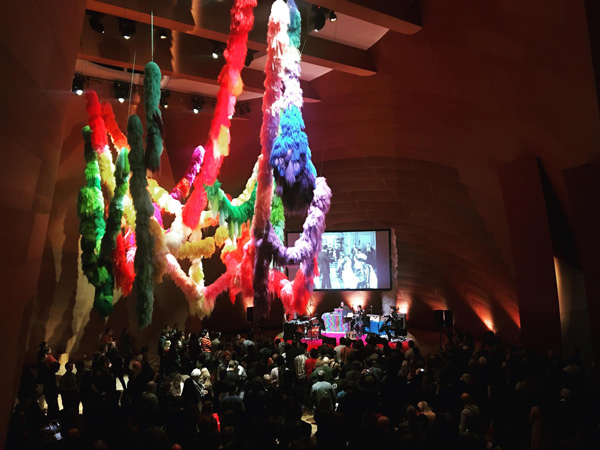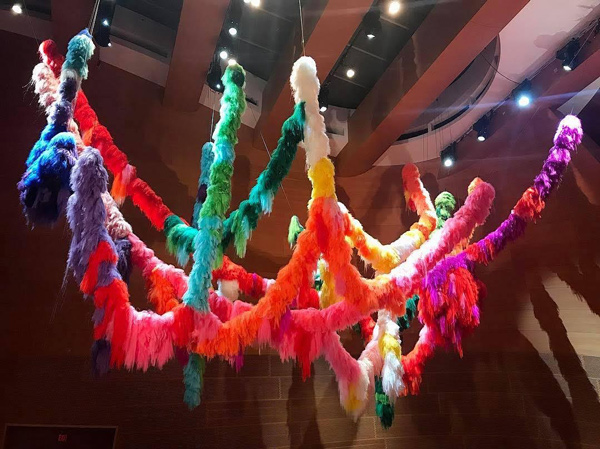The Reykjavík Festival at Walt Disney Concert Hall presents an opportunity to experience a site-specific installation by Icelandic artist Hrafnhildur Arnardóttir and a film by fellow Icelander Xárene Eskandar. The Festival brings up a larger question of cultural specificity amidst the ever-expanding waves of globalism, and whether it is possible to understand and integrate the kind of cultural differences presented in this kind of exchange, rather than simply marking them off as expressions of a culture more exotic than our own.
Arnardóttir’s Nervescape VI (2017) hangs above the BP Hall like an ornate and colorful set of boas, frozen in place, as if tossed upward from the floor below. The bright, nearly fluorescent colors of the artificial hair strands from which the individual links have been fashioned stand in counterpoint to the warm, wood surfaces of the surrounding walls. The variety of colors is either thrilling or disturbing, and may be a little of both. Impromptu stage and viewing platforms are similarly bedecked, appearing soft and amorphous, flocked with thick patterns of this hair-like material.
Arnardóttir, who lives in New York and Iceland, explores the use and symbolic nature of hair and the hair-like. Better known as Shoplifter, her transformation from her given name (which translates as Raven Battle Daughter of Eagle) occurred when someone, attempting to pronounce Hrafnhildur, asked if it was Shoplifter. Conceding, she even adopted the American preference for nicknames; she became Shopi.

Still from Xárene Eskandar’s Driving at the speed of the Nordic sun, 2014.
On opening night, the Icelandic group amiina played live musical accompaniment to Fantômas (1913-14), the black-and-white French silent film series directed by Louis Feuillade. Standing with their feet thoroughly embedded in Shoplifter’s colorful patterns, the band performed on a mix of traditional string quartet instruments—violin, viola, cello—and saws, kalimba, music boxes, percussion and electronics, which seemed to mirror the visual antimonies that filled the auditorium. Shoplifter’s rich decorative flourishes run countercurrent to the sleek subdued context of Gehry’s architecture; that tension made the relationship between the music, the installation and the site all the more captivating. Shoplifter’s use of humor and her coloristic overstatement obliquely address how identity is established. It is inevitable for anyone from sunny California to think about the origin of this artist in a land in which there are so many monochromatic stretches of land under what must, at times, look like an astoundingly luminous sky.
Xárene Eskandar, who divides her time between Los Angeles and Reykjavik, utilizes video and photography to explore how changes in temporal and spatial modes alter the perception of one’s body. Her single-take four-hour film, Driving at the speed of the Nordic sun (2014), even more overtly references Iceland’s austere landscape. Focusing on the changing horizon on December 11, 2014 from sunrise to sunset (a very brief duration of just four and a half hours), she intently explores the shifting of bodily self-perception that charts her own movement back-and-forth between this far northern location and Southern California. It is a site-specific film possible only in one location in Iceland, limited to a brief window of time. Eskandar spent considerable effort in determining when the extended single-take could be filmed without the interference of clouds or darkness to disrupt the shot.

Hrafnhildur Arnardóttir, Nervescape VI, 2017.
Her intent is to relay how one’s perception of self is indelibly linked to one’s incremental understanding of one’s own shadow, and how the radical shifts of a person’s geophysical configurations register that change. The film’s soundtrack samples a six-second segment from composer and Reykjavik Festival organizer Daníel Bjarnason’s Emergence 1. Silence, from Over Light Earth (2013); it is stretched into various lengths, creating new sound qualities and accompanying the film as it traverses the vast atmospheric-panoramic landscape, in its slow but significant changes. The almost monochromatic film sequence tracks along lines of frozen ice and sparsely occupied roadways. Tufts of wind-borne snow drift in and out of view while there are glimpses of an occasional truck or car being passed, and some signage whisks by very quickly.
Hrafnhildur’s story of renaming herself is an apt metaphor for how the differences these artists bring to LA can both be partially leveled and yet maintain the hallmarks of their otherness. Her extended moniker, and all of her a.k.a.’s, engage both strands of the culture-span that she (and Eskandar) inhabit and explore. Both sets of meaning remain at play, and they are not entirely subverted by the kind of permanent renaming that occurred at Ellis Island. Likewise, in these artworks, vestiges of the differences remain visible, encouraging the viewer to consider and straddle the divide.


